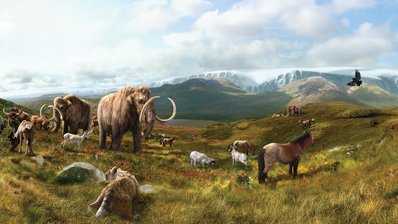
Horses roamed the North American continent for thousands of years before their disappearance and reintroduction by Spanish conquistadors and adventurers in the 1500s. Tiny samples of soil from Canadian permafrost reveal that they lived there alongside megafauna such as mammoths far longer than previously thought.
Researchers specifically looked at the transition from the frozen Pleistocene Age to the present Holocene era, a period of climatic instability 14,000 to 11,000 years ago. It was then that large mammals, such as saber-toothed cats, mammoths, mastodons and horses, disappeared from the record.
But although mammoths and horses were in decline before that climate instability began, they did not immediately disappear due to human overhunting as previously thought.
In a study published in the journal Nature Communications, American and Canadian scientists examined soil samples taken in the Klondike region of Canada’s Yukon territory, which borders Alaska and was once the gold prospecting mecca. The samples of frozen tundra offer a DNA record of past environments dating back 30,000 years.

“The rich data provides a unique window into the population dynamics of megafauna and nuances the discussion around their extinction through more subtle reconstructions of past ecosystems,” said study author Hendrik Poinar, who directs the Ancient DNA Centre at McMaster University.
The researchers used DNA capture-enrichment technology developed at McMaster University in Hamilton, Canada, to build a detailed picture of the changing flora and fauna inhabiting the area.
They reconstructed ancient environments by examining the billions of microscopic genomic sequences left behind by animals and plants in the core samples.
DNA evidence shows that wooly mammoths and horses continued to live in North America until as recently as 5,000 years ago, during the mid-Holocene period, which began about 11,000 years ago and persists to this day. Previously, researchers had assumed these animals died out some 9,700 years ago.

During the early Holocene period, when humans began ranging southward, the Yukon experienced significant ecological change. The grassy “Mammoth Steppe” was overtaken by mosses and shrubs on which large herds of horses and bison no longer grazed. Today, grasslands don’t thrive in the northern tier of the continent because megafauna no longer manage them.
“Now that we have these technologies, we realize how much life-history information is stored in permafrost,” said co-author Tyler Murchie of McMaster University. “The amount of genetic data in permafrost is quite enormous and really allows for a scale of ecosystem and evolutionary reconstruction that is unparalleled with other methods to date,” he said.
The researchers say there is an urgent need to gather and archive permafrost samples before climate change ensures they are lost forever.
Even though mammoths are extinct, horses persist in North America. “The horse that lived in the Yukon 5,000 years ago is directly related to the horse species we have today, Equus caballus,” said co-author Ross MacPhee of the American Museum of Natural History. “Biologically, this makes the horse a native North American mammal, and it should be treated as such.”
Edited by Siân Speakman and Kristen Butler
Recommended from our partners
The post Mammoth Discovery: Giant Tuskers And Wild Horses Roaming North America Died Out Only 5,000 Years Ago appeared first on Zenger News.



